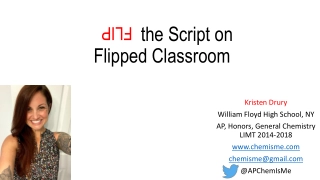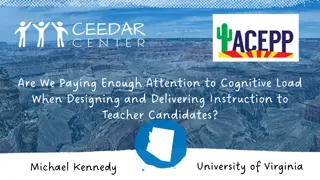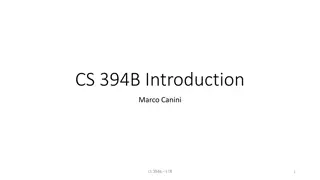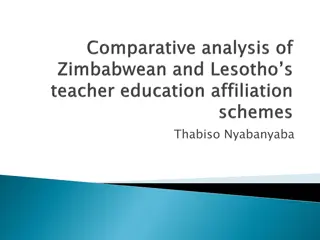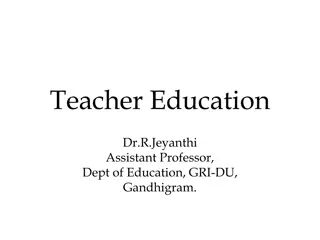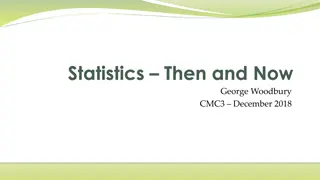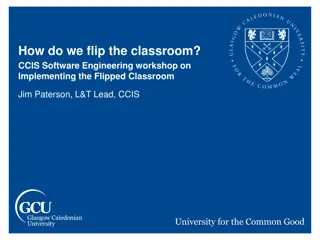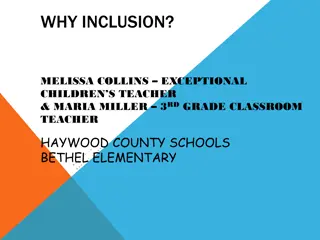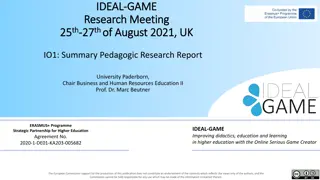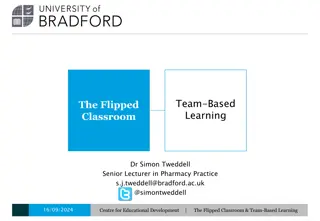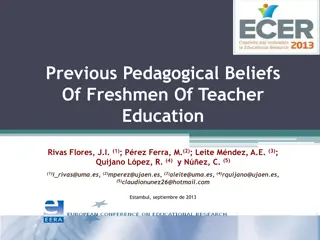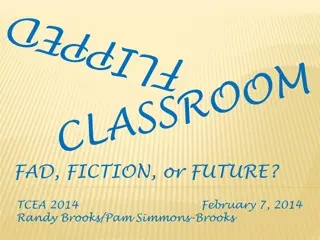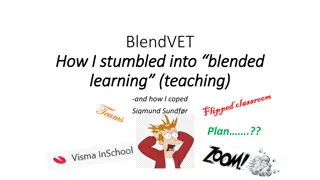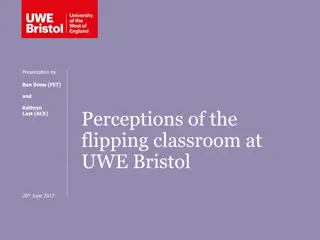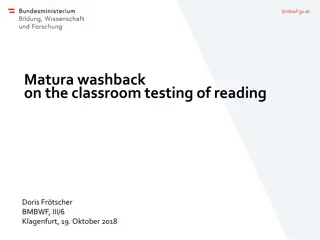Exploring Flipped Classroom in Teacher Education: Insights from Research
Flipped classroom, a form of blended learning, involves shifting direct instruction to individual spaces and creating interactive learning environments. This approach aims to enhance teacher education by utilizing various materials and methods both in and out of the classroom. Research evaluates the effectiveness of this model through peer-reviewed articles, with a focus on enhancing learning cultures and utilizing online components through learning management systems.
Download Presentation

Please find below an Image/Link to download the presentation.
The content on the website is provided AS IS for your information and personal use only. It may not be sold, licensed, or shared on other websites without obtaining consent from the author. Download presentation by click this link. If you encounter any issues during the download, it is possible that the publisher has removed the file from their server.
E N D
Presentation Transcript
Flipped classroom and its implications for teacher education: Lessons from research MANJULA VITHANAPATHIRANA
What is a flipped classroom? Flipped classroom/learning is one of the blended- learning approaches. The concept of the flipped classroom was proposed by Bergmann and Sams (2012). Blended learning is a formal education program that combine face-to-face instruction with computer-mediated instruction (Bonk & Graham, 2006). Blended learning is called different terms such as distributed learning, open and flexible learning, and hybrid learning. Blended learning in teacher preparation programs is in its infancy
Definition The Association of Flipped Learning Network (2014) officially proposes the following definition of flipped learning: Flipped Learning is a pedagogical approach in which direct instruction moves from the group learning space to the individual learning space, and the resulting group space is transformed into a dynamic, interactive learning environment where the educator guides concepts and engage creatively in the subject matter. students as they apply
Purpose and Method This study was done to explore the effectiveness of the flipped classroom for teacher education More than fifteen peer-reviewed journal articles published within the last five years and other web material were reviewed.
Shift in the learning culture/Inverted classroom The flipped classroom/learning is a reversed way of traditional teaching in which learners use new materials outside of class, such as at home, usually in the form of books or videos, and then perform their additional work, such as problem-solving, discussion or debates, in the classroom In a flipped learning setting, teachers make lessons available to students to be accessed whenever and wherever it is convenient for the student, at home, in class, on the bus, or even from a hospital bed. Teachers can deliver this instruction by recording and narrating screencasts of work they do on their computers, creating videos of themselves teaching, or curating video lessons from trusted Internet sites.
How does the on-line component work? The Learning management systems (LMS) are carefully designed to look good and be easy to use. Its structure, icons, colour Tasks presented weekly included introductory videos external tools that could aid the reflective learning process. Place each participant in an online group with other members of their academic discipline so that each could receive peer support whilst progressing through the program. Create a public portfolio space on the LMS for participants to upload their work and share it with their colleagues (if they chose to do so) once they finished through the LMS. Some and connection to
Misconceptions about Flipped learning some may think that flipping a classroom simply means moving some face-to-face teaching to the online space, rather than maximising the interactive face-to-face time by building complementary online resources The key difference between Web-enhanced courses and hybrid courses is that hybrids are redesigned courses that integrate online and classroom pedagogy to promote active independent learning Some critics of Flipped Learning have suggested that the instructional videos employed in the model will eventually replace educators. But in Flipped Learning model, skilled, Professional Educators are more important than ever, and often more demanding, than in a traditional one.
Issues Flipped classrooms rely heavily on learner preparation. To expect 100% of students to complete all outside work is not realistic some pitfalls of the flipped classroom include instructors preparation time; student resistance to taking on increased responsibilities for learning (i.e., increased responsibility on learners for their own learning can leave some learners feeling uncomfortable or abandoned); and culture shock for learners who are accustomed to rote, lecture- style learning. Atteberry (2013)
Advantages In the educational hold sector, capacity computer-based to remediate, technologies accelerate, review, preview, supplement or supercede the existing teaching/learning system. the This technique helped absent students attain good results. Resources can be borrowed from or shared with other educators and students around the country or around the globe, expanding access to top-tier teachers and instructional materials learners in flipped classrooms and those taught using traditional lecture classes have the same outcomes. Findlay-Thompson and Mombourquette (2013)
Advantages continued flipped classroom enhances what higher-education teachers want from students: self-guided reading and research, discussion and critical reflection. As Gibbs (1992) argues, the aim of all university classes is not to transfer knowledge within the confines of the teaching space, but rather to motivate self-guided, reflective learning flipped classrooms create a student-centered learning environment that increases technology usage and emphasizes collaboration, can study at their own pace and can view lectures not only on a PC but also on mobile devices whenever it is convenient to do so, promote student empowerment, development, and engagement. Higher self efficacy beliefs develop in trainees.
Factors affecting the Flipped classroom It appears that for the flipped classroom to be an effective teaching methodology, a number of processes must be in place. An instructor of hybrid courses needs to have a deep understanding of how people learn, what students learning styles are, and what technology can provide for the successful design of technology- integrated learning environments The reason that the flipped classroom approach may be spreading is that it increases opportunities for educators to produce more high-quality online content
For the future of FoE The gradual development of LMS Curriculum reorganization for online and face-to- face modalities for each topic Faculty teaching learning culture has to be transformed Training on developing online material Pilot studies needs to be done
References Atteberry, E. (2013) Flipped classrooms may not have any impact on learning. http://www.usatoday.com/story/news/nation/2013/ 10/22/flipped-classrooms-effectiveness/3148447/. Findlay-Thompson, S. and P. Mombourquette (2013) Evaluation of a flipped classroom in an undergraduate business course. Global Conference on Business & Finance Proceedings, 8(2): 138-145 Fitzpatrick, M. (2012) Classroom lecture goes digital. New York Times. Available from http://www.nytimes.com/2012/06/25/us/25ihteducsi de25.html?_r=0.
Kehoe et al (2018) The Double Flip: Applying a Flipped Learning Approach to Teach the Teacher and Improve Student Satisfaction, Journal of University Teaching & Learning Practice Volume 15 (1). Kim et al (2015)Blended learning in teacher education: Uncovering its transformative potential for teacher preparation programs https://www.researchgate.net/publication/280875610 Kurihara, Y (2016) Flipped Classroom: Effects on Education for the Case of Economics, Journal of Education and e-Learning Research, Vol. 3, No. 2, 65-71
Hamdan et al (2013) A review of flipped learning Hwang G J, Lai, C L and Wang S Y (2015), Seamless flipped learning: a mobile technology-enhanced flipped classroom with effective learning strategies, Journal of Computers in Education, Vol 2(4) Yoshida, H (2016) Perceived Usefulness of Flipped Learning on Instructional Design for Elementary and Secondary Education: With Focus on Pre-service Teacher Education, International Journal of Information and Education Technology, Vol. 6 (6)


